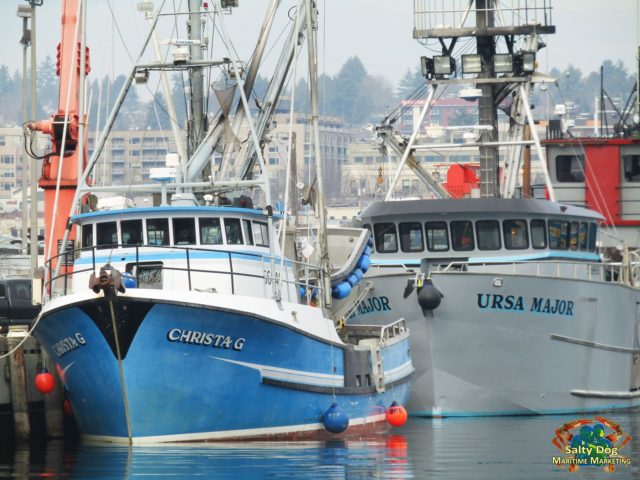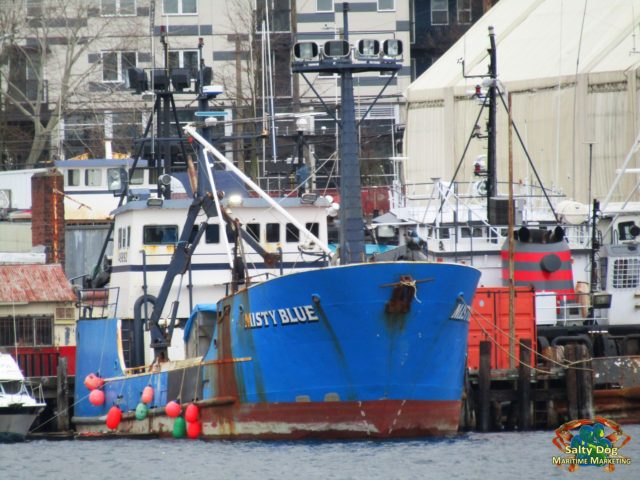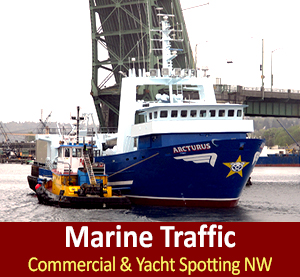
Christa G, AK Seine Fishing, URSA Major, AK Fishing Boat, Fishermen’s Terminal Winter, Commercial Photography by: Salty Dog Boating News, Salty Dog Maritime Marketing, The Marine Traffic Underway Source with the season fishing pulse
National Oceanic Atmospheric Administration’s, NOAA, fisheries management spokesperson Chris Oliver has assured Seattle’s fishermen and commercial fishing industry this past fall 2017, that the Trump administration is supportive of their fishing friendly agenda, threats to fishery habitat and fishing grounds loom large under the new regime at EPA and the Bureau of Ocean Energy Management. Trump’s fisheries support is much needed in this new year.
NOAA’s administration and support adds huge value toward regulating the commercial fishing industry and federally managed stocks. Additionally, Oliver has stated, “increasing recreational fishing and increasing recreational fishing opportunities is a priority of the administration.”

Jennifer A., Sister to Brenna A. Deadliest Catch Sean Dwyer Family Boats, AK Crabbers and Salmon Tenders, Commercial Photography by: Salty Dog Boating News, Salty Dog Maritime Marketing, The Marine Traffic Underway Source PNW to AK
Recently in 2017 just last year, EPA Administrator Scott Pruitt reopened the door for Pebble Ltd. to push through a mining plan that would greatly threaten the headwaters of the world’s largest wild salmon run. Back on Dec. 1, Pruitt announced that modern mining practices along with state and federal statutes adequately address the risks of operating hard-rock mines i.e. ‘Pebble.’
The EPA no longer requires mining companies to set aside funds to ‘clean up’ their own messes, which is shocking – since how tightly the EPA regulates the marine industry compared to the open policies with complete disregard for nature and habit caused by mining negative environmental affects. Asking more from the mining companies “would impose an undue burden on this important sector of the American economy,” Pruitt said. The EPA spent more than a billion dollars cleaning up abandoned hard-rock mining and processing sites across the country over the five-year period from 2010 to 2014. Alaska fisheries have stood the test of time by being the leading salmon run in the world; Pebble Mining absolutely has an effect on the salmon and their sustainability for years and seasons to come.

F/V Haida Warrior, AK Seine Fishing Boat, Jennifer A. Sister to Brenna A. Deadliest Catch Sean Dwyer Captain AK, Commercial Photography by: Salty Dog Boating News, Salty Dog Maritime Marketing, The Marine Traffic Underway Source PNW
Of course many commercial fisheries and fishermen, don’t want their income – ‘bread and butter affected by miners’ fishermen are proud to boast about the largest sockeye salmon fishery in the world. These fishermen absolutely oppose the mining, along with environmental groups and even some of Alaska’s normally proresource political figures. “Their problem is one of location, and that’s never going to change,” describes Taryn Kiekow Heimer, a senior policy analyst at the Natural Resources Defense Council. “They are just sitting at the headwaters of this incredibly productive ecosystem.” Minerals will always be in demand, as well as fresh wild seafood. The uncomfortable truth is the data of this debate – America and the world; has a massive appetite for minerals, including copper and gold. And that appetite is projected to grow. More recent data found that global copper demand could and would increase by 350 percent by 2050, exhausting current reserves sometime between 2035 and 2045, our future means these unsavory worlds need to somehow work together from land to sea.
Commercial Photography by: Salty Dog Boating News, Salty Dog Maritime Marketing, www.saltydogmatimemarketing.com The Marine Traffic Underway Source with the seasonal fishing pulse. Inquiry to: [email protected], Eat Fresh – Buy Wild!
Clearly mining and seafood are very lucrative business’. Both industries are lead by high risks of environmental circumstance and demand at land and at sea for workers, crew and safety. Fisheries and fishermen clean up their messes should they ever make them; shouldn’t large mining companies put their money where their mouth is and clean up their own inevitable messes that have negative lasting effects on the habitat and environment.

Misty Blue, Silver Bay Seafoods Salmon Tender Alaska, over at Ballard Oil, Ship Canal, Commercial Photography by: Salty Dog Boating News, Salty Dog Maritime Marketing, The Marine Traffic Underway Source NW to AK
Let’s hope in 2018 NOAA Fisheries stays to aim and protect the commercial fishing industry and the billions of dollars and revenue this industry has on the impacting worldwide markets, west coast and Alaska jobs; while protecting the salmon and wildlife habits and longevity.








